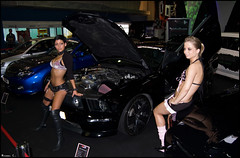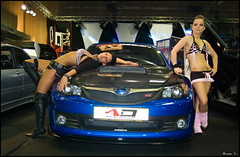Lamborghini Murcielago LP670-4 SuperVeloce, 2010
The Lamborghini Murciélago is one of the most extraordinary super sports cars of all time. Automobili Lamborghini has now expanded its model range with a new, exceptionally purist and even more extreme top model - the Lamborghini Murciélago LP670-4 SuperVeloce is even more powerful, lighter and faster than the Murciélago LP640. With the output of the 6.5 liter V12 increased to 670 hp and a weight reduction of 100 kg (220 lbs), the Lamborghini Murciélago LP670-4 SuperVeloce boasts a power-to-weight ratio of 2.3 kg (5.1 lbs) per hp. This catapults it from 0 to 100 km/h (62 mph) in a breathtaking 3.2 seconds and powers it on to a top speed of around 342 km/h (212 mph). Distinctive design refinements ensure that each of this 350-unit limited edition series conveys its full potential from the very first glance.
With its outstanding performance, razor-sharp precision and exceptional high-speed stability, the Lamborghini Murciélago LP 670-4 SuperVeloce is the ultimate performance car for advanced sports car drivers. The super sports car has been extensively redesigned with a new front and rear, an innovative engine bonnet and a choice of two aerodynamic set-ups featuring either a small or large rear spoiler. The interior in Alcantara and carbon fiber provides a purist and minimalist approach.
In order to achieve the substantial weight reduction of 100 kilograms (220 lbs), the Lamborghini Murciélago LP670-4 SuperVeloce was extensively reworked and redeveloped in virtually every aspect - from chassis to engine and transmission, right through to the interior. The increase in engine output from 640 to 670 hp is the result of optimized valve timing and a reworked intake system. The significantly modified aerodynamics with substantially increased downforce brings considerable improvement to vehicle stability at very high speeds. With the small standard-fit rear spoiler, top speed stands at 342 km/h (212 mph), while the large "Aeropack Wing" and its added downforce gives a top speed of 337 km/h (209 mph).
The design and aerodynamics
The Murciélago is an icon of the Lamborghini brand - a sports machine of menacing character and brutal power. Its unique design radiates a supreme form of highly concentrated sensuality. Wide, low, with its glass area pushed way forward and a long, taut back - the interplay between the soft contours of the basic form and razor sharp edges is the perfect expression of the Lamborghini design language. In the totality of its character, the Murciélago is without comparison on the sports car market.
Yet even a character like this can be further refined - the new Lamborghini Murciélago LP 670-4 SV is the more extreme, even more purist pinnacle of the model range. This is clearly evident from the very first glimpse of its completely redesigned front end - pulled way forward and finished in matt black paint, the carbon fiber front spoiler is connected to the front end via two vertical elements. The large air intakes for the front brakes are more powerfully emphasized. The new front fenders feature additional air intakes for brake ventilation. The air vent for the oil cooler located in the driver-side sill area is painted matt black to match the sills.
The modifications are even more apparent around the mighty engine bay of the Lamborghini Murciélago LP670-4 SuperVeloce. The twelve-cylinder engine is presented as an engineering masterpiece under a transparent engine bonnet that boasts a completely new architecture. Hexagonal polymer plates made from transparent polycarbonate are set on three levels within a carbon fiber framework. The layers are open towards the rear, playing a key role in the thermodynamics of the high-performance engine.
The impressive rear end of the SuperVeloce is dominated by a veritably noble, flat and extremely wide exhaust tailpipe and, on the underside, by a two-level diffuser system finished entirely in carbon fiber. The rear light clusters display their signals in that distinctive Y-shape that has been a fixed element of Lamborghini design since the Murciélago LP 640, Reventón and Gallardo LP560-4. The panel between the lights is made from carbon fiber, while the large intake mesh below expands across the full width of the rear end. Made from thick-walled aluminum, the hexagonal pattern is laser-cut and a Teflon coating provides the necessary heat protection.





































































